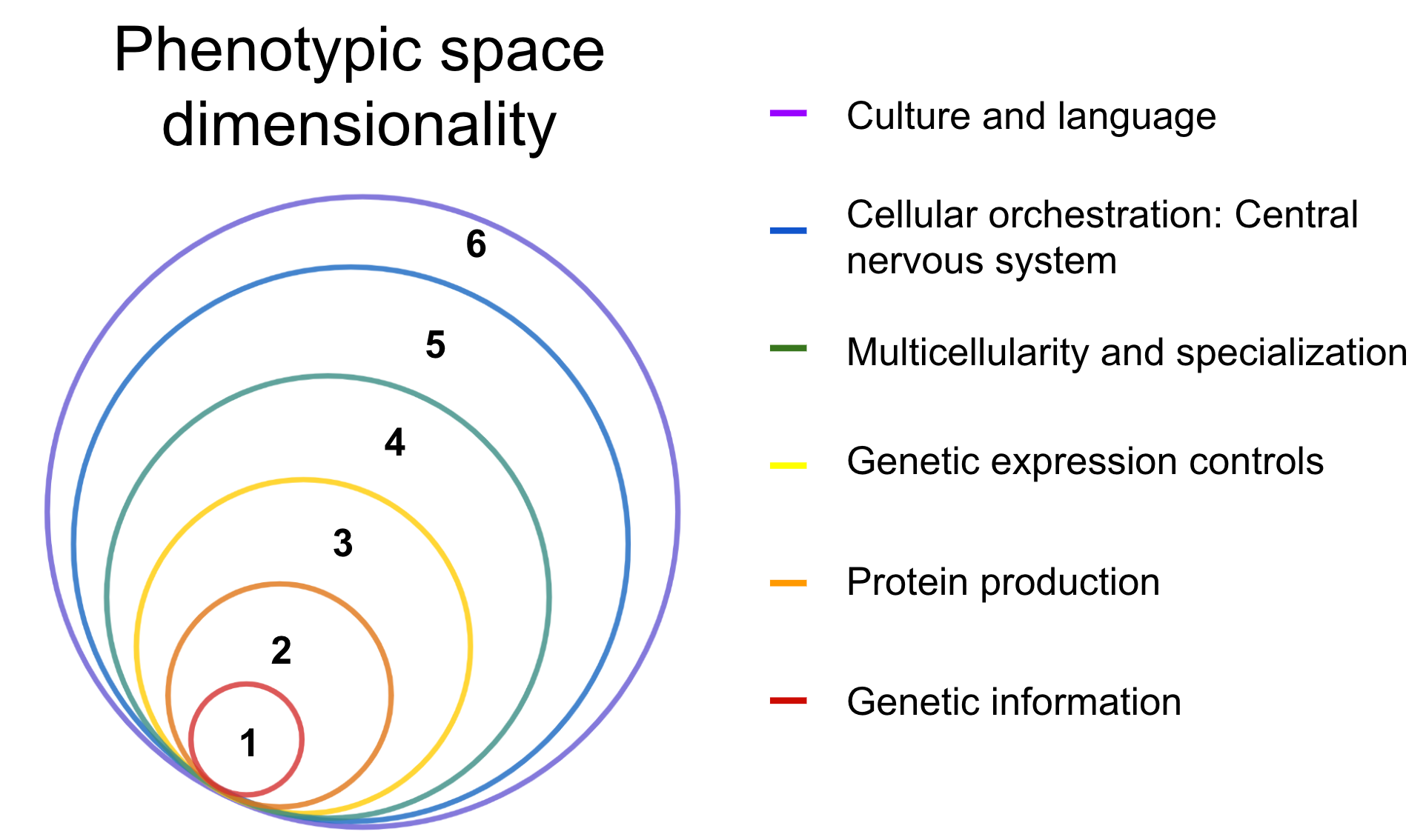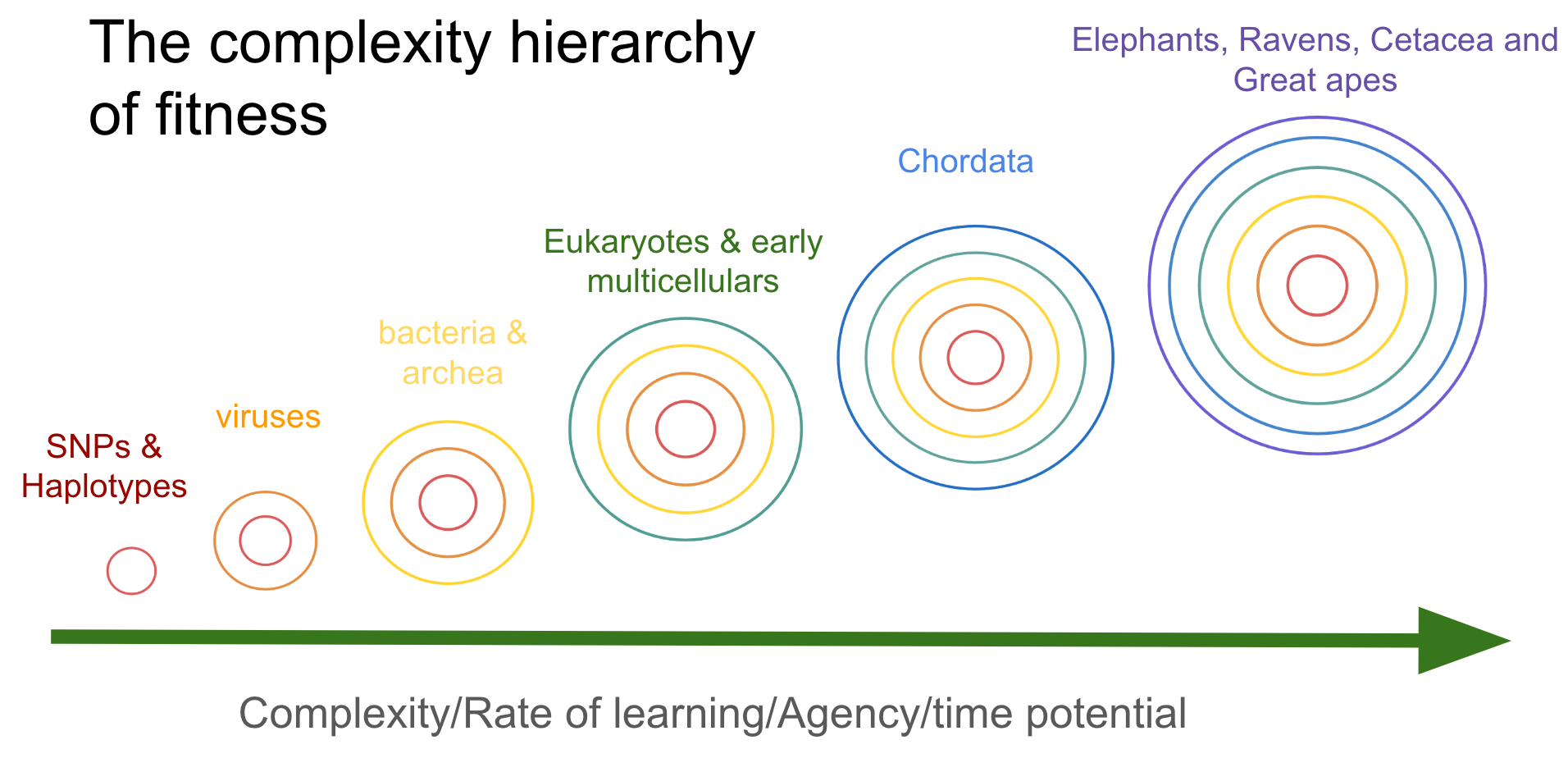The agentic interpretation of biological fitness
last updated (23/04/25)
Charles Darwin proposed reproduction and fecundity as the quantification of biological fitness, on the theoretical grounds that this allows an organism’s lineage to continue further in time. When considering which traits natural selection is influencing, maximizing trait fecundity is in alignment with this definition of fitness. Although this is a good approximation of what biology seems to be doing, I believe this to be a flawed interpretation of the evolutionary process. In this writing, I’ll attempt to describe a novel theory that positions the ability to learn and derive technologies at the heart of natural selection by re interpreting trait fitness. I call this the agentic view of fitness.
Let's theoretically assess fitness as the collection of traits or characteristics that allow a biological lineage to be represented in the future. Imagine that we are considering two individuals of a population of the same species. If the genetic lineage of individual A survives for 100 generations, while the genetic lineage of individual B only survives 50 generations, then we can conclude that individual A has a higher trait fitness value. In this sense, fitness is the set of traits or characteristics that render a biological entity robust to time. If you agree with me here, then we can move on to define that which grants higher fitness.
According to the extended evolutionary synthesis (which requires further extending), fitness is all about reproduction, not just achieving it but actively finding ways to reproduce more. This makes sense for a few reasons; in principle if you have two lineages of the same species and lineage A reproduces 5-fold more than lineage B, then surely purely based on statistics, organism A has far better chances to be more robust in time because it has 5x as many trials. The environment could catastrophically impact one of any lineage by chance, and so the lineage that has a higher copy number is at better odds of advancing through time. Following this logic, it is very reasonable to say that fitness is all about reproduction, since it reduces survival capability to a game of numbers.
Notice that in this story of survival there are two main players, the biological system and an environment in which survival takes place. Imagine that in order to achieve reproduction, the biological system is at a constant search for solutions to environmental problems. In fact, how well it circumvents the environmental challenges is what will dictate if the system is capable of achieving the noble goal of reproduction. But if this is the case, then wouldn’t evolution be about circumventing environmental challenges rather than be about maximally reproducing?
Getting to the point where you get to reproduce is extremely costly. It is about having a good immune system, sensory awareness to survive predation, a set of tools to obtain food to grow to reproductive age and finally being a good candidate for potential partners. In other words, natural selection is not impacting reproduction mechanisms per se, but rather it is impacting a variety of different traits, each of which offer increased robustness and ability to circumvent the environmental stresses. Making reproduction more reliable is very different from reproducing more.
Moreover, If fitness was all about achieving higher numbers of offspring, how come evolution and natural selection did not optimize reproduction from the start? How come there is no minimal biological being that skips the incubation period and is solely preoccupied about replicating as much of its genome as possible? Why did the technology of birth and death emerge under these circumstances? And most importantly, how does this explain the complexity gradient of the biological systems we see today?
The simplest explanation of why we don’t see these minimal PCR-like beings in our immense biodiversity is because evolution is not selecting for organisms like those. Maybe what gets you the furthest in time has a lot more to do with accumulating complexity. Maybe biological fitness is ill-defined and requires an urgent update. In this direction, I propose the agentic view of fitness, an interpretation of evolution that positions biological systems (e.g. species) as general purpose learning algorithms that achieve technological solutions and adaptations through learning and the accumulation of complexity.
In this picture, reproducing more doesn't necessarily grant you more robustness to time, but what does do that is learning and being able to exploit genetic diversity for technological breakthroughs through the process of birth and death. It envisions that the selective pressures are producing beings that have gathered a great deal of understanding about the substrate they are growing on. How much complexity or learning capacity a given species has, renders them robust to potentially harsher environmental perturbations.
In a sense, evolution is sampling the state space of genomic configurations available from mutations and the genetic pool and looking for the most optimal solution to a set of very precise problems. It is evaluating learning in terms of producing the technologies that render a biological system more robust to specific challenges.
The agentic landscape of life largely explains why higher order organisms do not reproduce as much as lower order organisms. In the biological story of evolution, there comes a critical point where simple offspring maximization is no longer an effective strategy for producing better and more efficient learning. Instead, we can invoke the complexity of an organismal phenotype to explain the rate and kind of learning that is taking place for that specific genetic lineage. We humans do not go around making as many babies as we possibly can because the evolutionary process has brought us to a state where that strategy is no longer required to increase our odds of survival as a species. We are far better off learning about our environment, about the world around us and about physics in order to assure that humanity continues thriving for many years to come. In this learning-centric view, reproduction is one of many crucial technologies that life found in order to persist in time because the process of death and birth is a great implementation of a general purpose learning algorithm; but it is no longer the ultimate goal.
With this new ordering principle, we can draw a hierarchy of agency that correlates with: a) survival potential across increasingly difficult environmental challenges, b) Rate of learning and technological discovery and c) Dimensional complexity of phenotypes. I propose that life can be classified across a hierarchy of phenotypic dimensions that act as an ordering paradigm for the rate of learning and technological discovery.

A possible taxonomy of phenotypic space dimensions

A hierarchy of organismal complexity
Among other things, this learning-centric vision of evolution offers new explanations, perspectives and considerations to the following:
1) Where are the pure replicators?
2) Why higher phenotypic complexity life reproduces less than their lower phenotypic complexity counterparts?
3) Why did the process of birth and death evolve?
4) Predicts that higher complexity organisms have longer time potentials than lower complexity organism.
5) Offers a general metric with which to quantify fitness across the tree of life by proxy of their phenotypic dimensionality. (likely something to do with the overall energy expenditure of a species.)
6) Offers new directionality to what was previously thought of as a random process.
7) Answers why there's little evidence for fecundity being under selection in humans and other species.
8) It bridges physics and biology by postulating an arrow of time that increases agency and system complexity; re-contextualizes the second law of thermodynamics.
9) Draws skepticism on population genetic derivations of higher population size driving the effectiveness of natural selection.
10) Explains that genome to phenotype mappings are difficult because they neglect the various phenotypic dimensions.
Finally, I would like to give credit to (Lourenço, Glémin, and Galtier 2013) for introducing and testing key ideas about the role of environment and organismal complexity so succinctly. Although I had already come to realize the incompatibility of the fitness definition prior to having encountered their research; upon reading, it inspired and motivated a new set of arguments and considerations.
“The rate of environmental change and, interestingly, the dimensionality of phenotypic space (organismal complexity) affect the adaptive rate more deeply than does the effective population size.”
